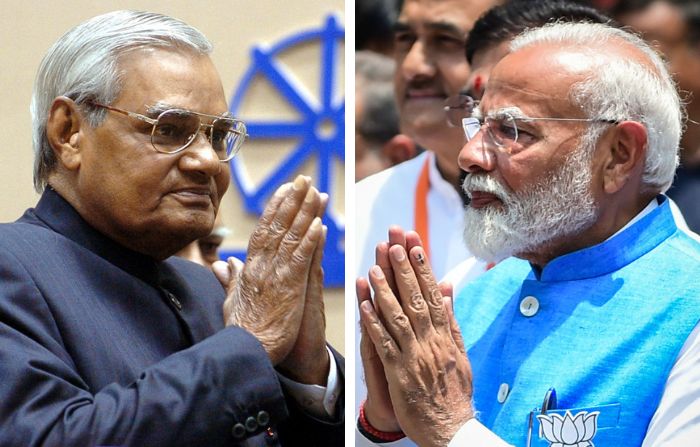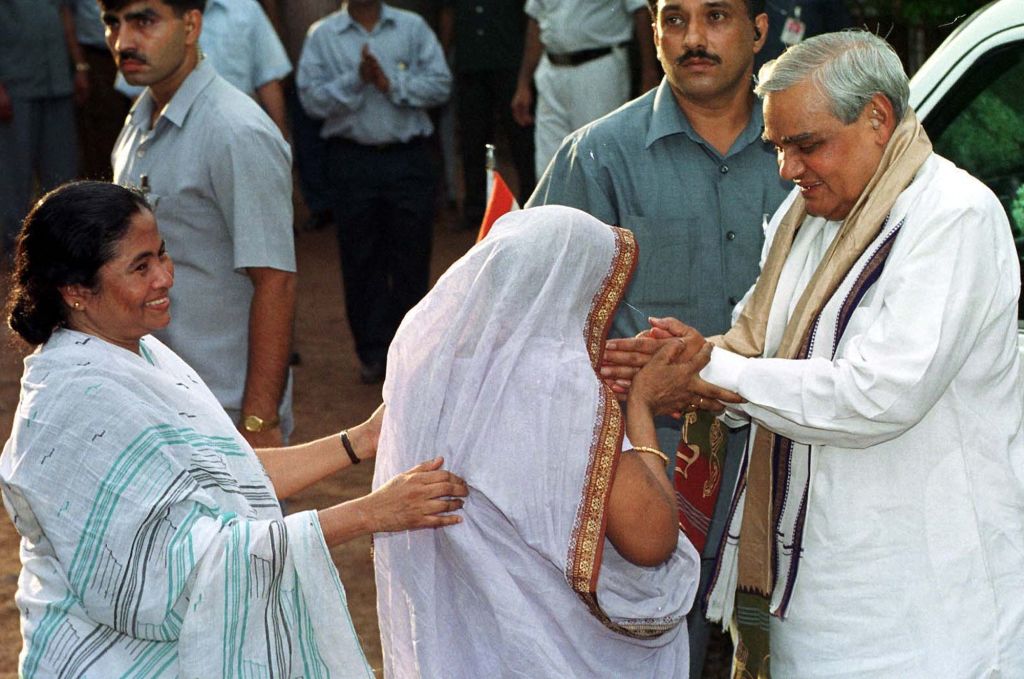- Wednesday, April 23, 2025
Comparisons were being made between the two leaders of the Bharatiya Janata Party since Atal Bihari Vajpayee was known to be a master of handling ‘coalition politics’.

By: Shubham Ghosh
IN January 2019, MK Stalin, chief minister of the southern Indian state of Tamil Nadu, had remarked that prime minister Narendra Modi was no Atal Bihari Vajpayee and it was an “irony” that the current PM compared himself with his predecessor, who died the preceding year.
Months ahead of that year’s general elections, the southern leader said that his Dravida Munnetra Kazhagam (DMK) would never ally with the BJP, adding that an alliance under Modi was not a healthy alliance. Stalin’s remarks came in response to the prime minister’s statements made a day before that the Hindu nationalist party was open to making alliances and “cherishes its old friends”. His words were seen as an outreach to the parties of Tamil Nadu where the BJP has remained a fringe player.
Modi, who was interacting with workers of his BJP in Tamil Nadu, spoke about the “successful coalition politics” of Vajpayee in the 1990s. He even commented that the BJP’s doors are “always open” in response to a BJP worker’s question on whether the party would ally with some of Tamil Nadu’s big parties such as the DMK or All India Anna Dravida Munnetra Kazhagham (AIADMK).
Read: World leaders congratulate Modi on winning third straight term
“Twenty years ago, visionary leader Atalji brought in a new culture in Indian politics, that of successful coalition politics. He gave utmost importance to regional aspirations…BJP has followed the way Atalji has shown us,” he said.
The BJP had in the past made alliances with both the DMK and its rival AIADMK when Vajpayee was the prime minister but those tie-ups did not eventually survive.
In the last five years, a number of key parties have left the NDA, including Telugu Desam Party (TDP), Shiv Sena and Shiromani Akali Dal (SAD) for reasons related to their own regional politics. Yet, the NDA went on to form governments in New Delhi for two successive terms, thanks to the overwhelming personal cult of Modi who led his own party to achieve a majority on its own on both occasions, reducing the significance of the NDA.
Read: ‘Kingmakers’ could be back as Modi’s BJP fails to get majority
But the election results of 2024 have brought the NDA back into reckoning as the BJP has failed to win a majority on its own. This also brings back into focus the significance of regional leaders such as Nitish Kumar of the Janata Dal-United (JDU), which has joined and left the NDA a number of times since 2013 when Modi was first chosen as the prime ministerial candidate.
Chandrababu Naidu, leader of the Telugu Desam Party (TDP), which is also a former member of the NDA and had even moved a no-confidence motion against the Modi government in 2018 over alleged non-allocation of funds to his state of Andhra Pradesh, is the other leader who has done well as part of the NDA in this election.
The NDA has won 292 out of 543 seats and of them, 28 belong to the JDU and TDP. The majority mark is 272.
With the days of coalition politics back into the centrestage, Stalin’s 2019 remark becomes all the more significant.
In Indian politics, coalition was once the norm rather than exception and a prime minister such as Vajpayee had mastered the “dharma” of such politics and executed it successfully during his six continuous years in power. He had even faced adversity in 1999 when withdrawal of support by the late AIADMK leader J Jayalalithaa had seen his government collapse after just 13 years but yet, the leader managed to come back to power and run a government for the entire term between 1999 and 2004.
Modi, on the other hand, has been more of a ‘king’ who never needed a ‘maker’. Be it in his own state of Gujarat where he won three consecutive terms as the chief minister between 2002 and 2014 when he became the PM, or in the general elections of 2014 and 2019, his BJP won a majority verdict on its own and there was no need for alliance partners to save his government.
Things were back to the Vajpayee era for the BJP on June 4 after it fell short of the majority and would require support from allies to run the government for the next five years. Under Modi, however, it would require only a support of 32 seats to maintain the majority while under Vajpayee, it needed 90. Yet, could the task be more difficult for the current PM than his predecessor?
Vajpayee was a master in carrying out “coalition dharma” — a term he himself had coined.
Here is an example.
In 2000, the veteran leader faced one of his allies Mamata Banerjee — a mercurial leader from the eastern state of West Bengal and leader of the Trinamool Congress which was an ally of the BJP then — angry over a government decision on the railways that she as the then railway minister felt would hurt her state’s interest.

Despite being the alliance’s boss, Vajpayee did not summon Banerjee to Delhi and instead reached out to her by visiting her humble residence in Kolkata. He spoke with Banerjee’s mother, enquired about her health and even told her that her talented daughter was sometimes stubborn, something mother agreed with. A former Indian diplomat wrote the story in a newspaper in 2018, after Vajpayee’s passing away.
Through the homely talks and the prime minister’s visit to the house of an alliance partner and praising her humble lifestyle, the PM made his allies understand that he was just not the head of an alliance but also a father figure and hence was respected by all.
In times of Modi, however, such scenes were not seen, at least in the open. The Sena of former firebrand Hindu leader Balasaheb Thackeray found itself getting split after leaving the NDA in 2019 with one faction joining the BJP while the SAD leadership still is not much convinced about returning to the NDA’s fold.
Coalition politics is not something that had started with Vajpayee either. Sometimes, it ran successfully while at other times, it did not.
The first time a coalition government came to rule India was in 1977 when the Congress’s Indira Gandhi lost, right after the Emergency was lifted. The coalition included 11 parties but did not last for more than three years after seeing two prime ministers.
While Rajiv Gandhi led a majority government between 1984 and 1989, the next 25 years saw coalition governments ruling India. While prime ministers such as PV Narasimha Rao (1991-96), Vajpayee (1999-2004) and Manmohan Singh (2004-14) were successful in leading coalition governments to last the full distance, there were those such as VP Singh (1989-90), Chandra Sekhar (1990-91), HD Deve Gowda (1997-98) and Inder Kumar Gujral (1997-98) who had failed to survive full terms because their minority governments faltered. In fact, Vajpayee, too had failed as the prime minister on two occasions (1996 and 1998-99) before lasting an entire term.
The BJP has brought together more than two dozen parties this time to counter the opposition Indian National Developmental Inclusive Alliance, which also comprises more than two dozen parties, which was formed last year with an aim to deny Modi his third successive term.
While it has failed to reach its goal, it has made a significant gain by reducing the BJP’s strength the the parliament (it went down to 240 seats from 303 in 2019) and now, the ball is in the court of Modi, a leader who is not tested much in running the ‘coalition dharma’ to prove his critics wrong in the next five years.